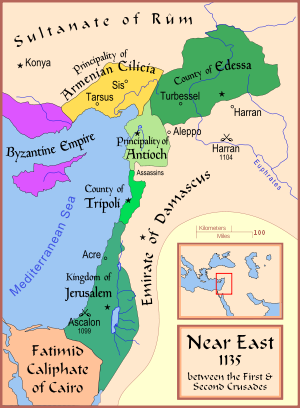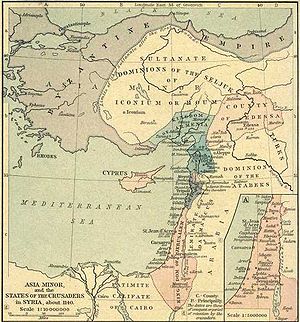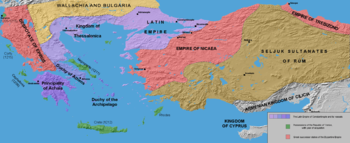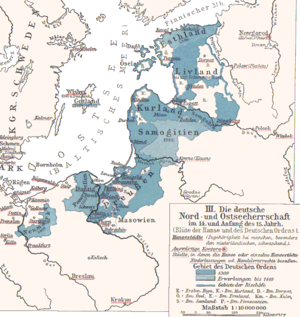- Crusader states
-
The Crusader states were a number of mostly 12th- and 13th-century feudal states created by Western European crusaders in Asia Minor, Greece and the Holy Land (ancient and modern Israel and the Palestinian region), and during the Northern Crusades in the eastern Baltic area. The name also refers to other territorial gains (often small and short-lived) made by medieval Christendom against Muslim and pagan adversaries.
Contents
Background
Beginning in the 7th century Muslim rulers began expanding their territories into Christian Roman/Byzantine lands conquering Egypt and the Levant and gradually taking over all of North Africa, much of Southwest Asia, and most of the Iberian Peninsula. The Eastern Romans, or Byzantines, partially recovered lost territory on numerous occasions but over time gradually lost all but Anatolia and parts of Thrace and the Balkans. In the West the Roman Catholic kingdoms of northern Iberia launched a series of campaigns known as the Reconquista to reconquer the peninsula from the Arabized Berbers known as Moors (who called it al-Andalus). The conquered Iberian principalities are not customarily called Crusader states, except for the Kingdom of Valencia, despite fitting the general criteria.[1]
In 1071 the Byzantine army was defeated by the Muslim Seljuk Turks at the Battle of Manzikert resulting in the loss of most of Asia Minor. The situation represented a serious existential threat for the Eastern Orthodox Byzantine Empire. The Emperor sent a plea to the Pope in Rome to send military aid with the goal of restoring the formerly Christian territories to Christian rule. The result was a series of western European military campaigns into the eastern Mediterranean, known as the crusades. Unfortunately for the Byzantines, the crusaders had no allegiance to the Byzantine Emperor and so established their own states in the conquered regions, including the heart of the Byzantine Empire itself.
Mediterranean
In the Levant
The first four Crusader states were created in the Levant immediately after the First Crusade:
- The first Crusader state, the County of Edessa, was founded in 1098 and lasted until 1149.
- The Principality of Antioch, founded in 1098, lasted until 1268.
- The Kingdom of Jerusalem, founded in 1099, lasted until 1291, when the city of Acre fell. There were also many vassals of the Kingdom of Jerusalem, the four major lordships (seigneuries) being:
- The County of Tripoli, founded in 1104, with Tripoli itself conquered in 1109, lasted until 1289.
The Armenian Kingdom of Cilicia had its origins before the Crusades, but was granted the status of a kingdom by Pope Innocent III, and later became semi-westernized by the (French) Lusignan dynasty.
Cyprus
During the Third Crusade, the Crusaders founded the Kingdom of Cyprus. Richard I of England conquered Cyprus on his way to Holy Land. He subsequently sold the island to the Knights Templar who were unable to maintain their hold because of a lack of resources and a rapacious attitude towards the local population which led to a series of popular uprisings. The Templars promptly returned the island to Richard who resold it to the displaced King of Jerusalem Guy of Lusignan in 1192. Guy went on to found a dynasty that lasted until 1489, when the widow of King James III The Bastard, Queen Catherine Cornaro, a native of Venice, abdicated her throne in favour of the Republic of Venice, which annexed the island.[2] For much of its history under the Lusignan Kings, Cyprus was a prosperous Medieval Kingdom, a commercial and trading hub of Western Christendom in the Middle East.[3] The Kingdom's decline began when it became embroiled in the dispute between the Italian Merchant Republics of Genoa and Venice. Indeed the Kingdom's decline can be traced to a disastrous war with Genoa in 1373-74 which ended with the Genoese occupying the principal port City of Famagusta. Eventually with the help of Venice, the Kingdom recovered Famagusta but by then it was too late and in any event, the Venetians had their own designs on the island. Venetian rule over Cyprus lasted for just over 80 years until 1571, when the Ottoman Empire under Sultan Selim II Sarkhosh invaded and captured the entire island. The battle for Cyprus between Venice and the Ottoman Empire was immortalized by William Shakespeare in his play Othello, most of which is set in the port city of Famagusta on the eastern shores of the island.
In the Balkans
After the Fourth Crusade, the territories of the Byzantine Empire were divided into several states, beginning the so-called "Francocracy" (Greek: Φραγκοκρατία) period:
- The Latin Empire in Constantinople (1204–1261)
- The Kingdom of Thessalonica (1205–1224)
- The Principality of Achaea (1205–1432)
- The Lordship of Argos and Nauplia (1205–1388)
- The Duchy of Athens (1205–1458)
- The Margraviate of Bodonitsa (1204–1414)
- The Duchy of Naxos (1207–1579)
- The Duchy of Philippopolis (1204–1205)
Several islands, most notably Crete (1204-1669), Euboea (Negroponte, until 1470), and the Ionian Islands (until 1797) came under the rule of Venice.
These states faced the attacks of the Byzantine Greek successor states of Nicaea and Epirus, as well as Bulgaria. Thessalonica and the Latin Empire were reconquered by the Byzantine Greeks by 1261. Descendants of the Crusaders continued to rule in Athens and the Peloponnesus (Morea) until the 15th century when the area was conquered by the Ottoman Empire.
- The military order of the Knights Hospitaller of Saint John established itself on Rhodes (and several other Aegean islands; see below) in 1310, with regular influx of new blood, until the Ottomans finally drove them out (to Malta) in 1522.
- the island of Kastellorizo (like Rhodes a part of the Aegean Dodecanese island group) was taken by the Knights of St. John Hospitaller of Jerusalem in 1309; the Egyptians occupied it from 1440 until 1450; then the Kingdom of Naples ruled; Venetian rule began in 1635 (as Castellorosso); all these states, excluding the Egyptians, were Catholic; Ottoman rule was established in 1686, although Greeks controlled the island during the Greek War of Independence from 1821-1833.
- other neighbouring territories temporarily under the order were: the cities of Smyrna (now Izmir; 1344–1402), Attaleia (now Antalya; 1361–1373 and Halicarnassos (now Bodrum;1412-14..), all three in Anatolia; the Greek Isthmus city of Corinth (1397–1404)), the city of Salona (ancient Amphissa; 1407–1410) and the islands of Ikaria (1424–1521) and Kos (1215-1522), all now in Greece
In the Baltics
In the Baltic region, the indigenous tribes in the Middle Ages at first staunchly refused Christianity. In 1193, Pope Celestine III urged to a crusade against the heathens which included the Old Prussians, the Lithuanians and other tribes inhabiting Estonia, Latvia and East Prussia. This period of warfare is called the Northern Crusades.
In the aftermath of Northern Crusades William of Modena as Papal legate solved the disputes between the crusaders in Livonia and Prussia.
- By dividing the lands of the Terra Mariana between the crusading order of Livonian Brothers of the Sword and the Church five principalities were created:
- Archbishopric of Riga,
- Bishopric of Courland,
- Bishopric of Dorpat,
- Bishopric of Ösel-Wiek,
- The lands of the Livonian Brothers of the Sword.
- The Estonian lands controlled by Danish crusaders were annexed with Denmark as
- Duchy of Estonia[4] until it was ceded to the Teutonic Order state in 1346.
- In the Prussian region William of Modena divided the lands between Teutonic knights and the Church by creating 4 Prince-Bishoprics under the Archbishopric of Riga:
- Bishopric of Culm,
- Bishopric of Pomesania,
- Bishopric of Ermland,
- Bishopric of Samland.
See also
- List of Crusader castles
- Map of the Crusader states from Muir's Historical Atlas (1911)
References
- ^ See for example The Crusader Kingdom of Valencia: Reconstruction on a Thirteenth-Century Frontier, R.I. Burns, SJ, Harvard, 1967 (available online)
- ^ Edbury P.W., The Kingdom of Cyprus and the Crusades 1191 - 1374, Cambridge University Press (1991)
- ^ Edbury P.W., The Kingdom of Cyprus and the Crusades 1191 - 1374, Cambridge University Press (1991)
- ^ High medieval rural settlement in Scandinavia; The Cambridge History of Scandinavia By Knut Helle; p. 269 ISBN 0521472997
Sources and references
- Westermann, Großer Atlas zur Weltgeschichte (in German)
Crusader States Levant Latin Greece Baltic Categories:
Wikimedia Foundation. 2010.




